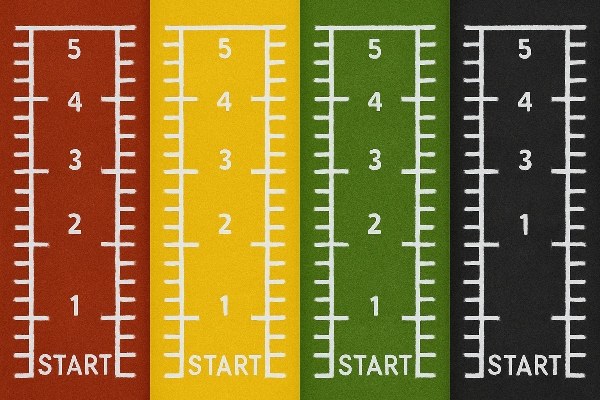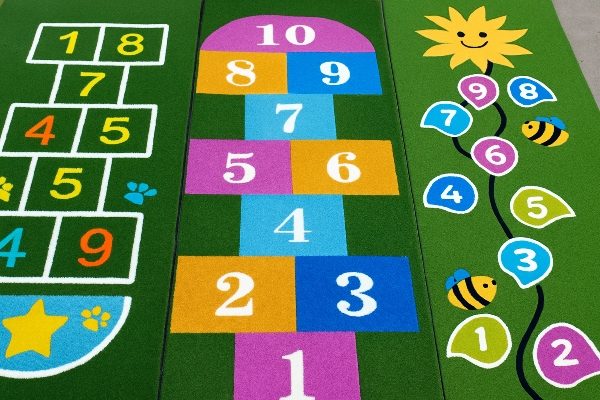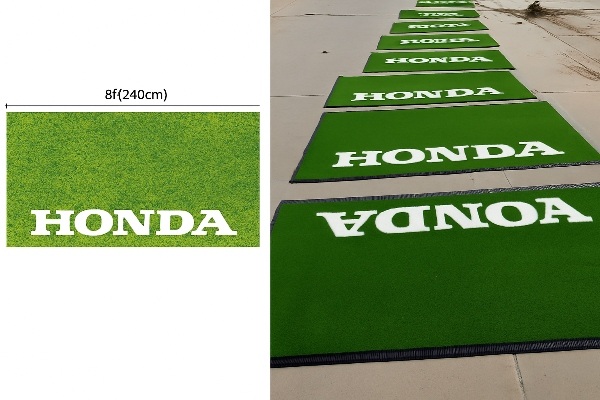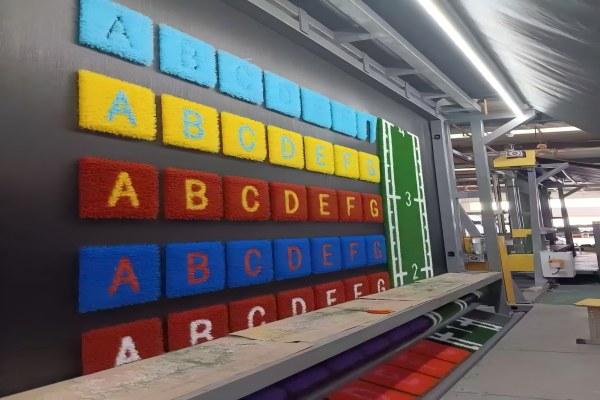Struggling to make your sports field or commercial space stand out? A plain green field is functional but forgettable. Adding a custom logo or design can make all the difference.
The best way to get a custom design on artificial grass is through one of two methods. The first is tufting, where different colored yarns are woven directly into the turf backing during production. The second is waterjet cutting, where designs are precisely cut from colored turf and inlaid like a puzzle.

Getting a custom logo on your turf seems complex, but it’s a very manageable process when you know the steps. I’ve helped countless clients transform their ideas into reality, from simple field markings to incredibly detailed company branding. The final result is always worth the effort, creating a unique and professional look that lasts for years. Let’s walk through how you can do it for your own project.
What Custom Designs Are Possible with Artificial Grass?
Are you worried your design idea is too complex for artificial grass? You might feel limited to simple shapes or letters. The good news is that modern technology makes almost anything possible.
Virtually any design can be created with artificial grass. This includes simple letters, intricate company logos, school mascots, and full-field decorative patterns. The design is made either by tufting colored yarns directly or by inlaying precisely cut pieces of different colored turf.

I remember a client who wanted their university’s detailed griffin mascot on the center of their football field. They were convinced it couldn’t be done well. We showed them how the waterjet inlay method could capture every detail, from the feathers on the wings to the sharp look in its eyes. The project was a huge success. Your creativity is really the main limit. We primarily use two methods to bring these designs to life.
Manufacturing Methods for Custom Turf
Each method has its strengths, and the best choice depends on the complexity of your design and your budget.
| Feature | Tufting Method | Waterjet Cutting (Inlay) Method |
|---|---|---|
| Complexity | Best for simpler designs, lines, numbers | Ideal for highly detailed, complex logos |
| Durability | Extremely high, as it’s part of one piece | Very high, seams are securely glued |
| Seams | No seams, completely integrated | Visible seams, but very tight and durable |
| Cost | Generally more cost-effective for simple art | Higher cost due to precision cutting/labor |
Choosing the right method is the first step. For basic field markings or simple block letters, tufting is perfect. For that detailed griffin mascot, waterjet cutting was the only way to go.
The Step-by-Step Process for Ordering Custom Logo Turf?
The idea of ordering a custom product from overseas can feel risky. You might worry about miscommunication or making a mistake. The key is to follow a clear, structured process with your supplier.
Ordering custom turf involves a few simple steps. First, submit your design for a quote. Next, review and approve the detailed CAD drawing we provide. Then, production begins. Finally, your custom turf is inspected and shipped. Clear communication at each stage is essential.

From my experience on the factory floor, I know how important a good plan is. A mistake in the beginning becomes a big problem at the end. That’s why we have created a process that protects you and ensures you get exactly what you envisioned. It moves your idea from a simple file on your computer to a finished product on your field, with checkpoints along the way. Here is how it works.
Our 5-Step Custom Order Process
- Consultation and Design Submission: It all starts with your idea. You send us your design file or concept. We’ll discuss the project with you to understand your needs and determine the best manufacturing method.
- Quotation and CAD Drawing: Based on the consultation, we provide a detailed price quote. More importantly, our engineers create a computer-aided design (CAD) proof. This drawing shows the exact dimensions, colors, and layout for your approval.
- Sample Production (Optional): For large or highly detailed projects, I always recommend a small-scale sample. This lets you physically see and approve the quality, colors, and feel before we produce the full order. It provides ultimate peace of mind.
- Full Production: Once you give final approval on the CAD drawing and/or sample, our factory gets to work. The machines are programmed, and your custom turf is manufactured to the exact specifications.
- Quality Control and Shipping: Before anything leaves our factory, we conduct a final quality inspection to ensure it matches the approved design. Then, we carefully roll and pack your turf for secure international shipping.
Key Requirements for a Custom Grass Order (MOQ, File Types, etc.)?
Are you ready to order but not sure what information to provide? Missing details can cause delays and frustration. Knowing the key requirements upfront makes the process much smoother for everyone involved.
For a custom order, you will need a high-resolution vector file of your design, like an .AI or .EPS. You also need to meet the manufacturer’s Minimum Order Quantity (MOQ) and be aware of production lead times, which are longer than for standard turf.

I’ve seen projects get delayed simply because the client sent a low-quality .JPG file they pulled from their website. The machines that tuft or cut the turf are incredibly precise, and they need equally precise instructions to work from. Providing the right information at the start is the most important thing you can do to ensure a fast and accurate production run. Here are the core things we will ask for.
Design File Format
The single most important item is your design file. We need a vector file. Common vector formats are .AI (Adobe Illustrator), .EPS, or .DXF. Unlike pixel-based files (.JPG, .PNG), vector files can be scaled to any size—even the size of a football field—without losing any quality or sharpness.
Minimum Order Quantity (MOQ)
Factories have an MOQ because setting up the machines for a custom job takes time and materials. This setup cost is the same whether we make one square meter or 100 square meters. The MOQ ensures the production run is efficient. It varies by factory and design complexity, so always ask about it early.
Color Matching
To ensure the colors in your logo are perfect, we use the Pantone Matching System (PMS). If you provide the PMS codes for your brand colors, we can match the yarn color precisely. This avoids any confusion over shades of blue or red and guarantees brand consistency.
Lead Time
Custom orders naturally take longer than standard turf. The process includes design proofing, machine setup, and the manufacturing itself. A realistic lead time is often between 3 to 5 weeks for production, plus shipping time. We will always give you a clear timeline before you order.
Why Choose QH Grass for Your Custom Turf Project?
You need a partner you can trust for a custom project. You worry about suppliers who promise anything but deliver poor quality. Our combination of engineering expertise and a transparent process removes that risk.
QH Grass is your ideal partner because we combine deep technical knowledge with a customer-first approach. My experience as an engineer ensures your design is produced correctly. Our clear process, from CAD drawings to final inspection, guarantees a high-quality result that matches your vision.
[](https://placehold.co/600×400 “QH Grass Factory for Custom Turf”)

My career didn’t start in sales. It started in the technical department of a turf workshop. I know how these machines work, what they can and cannot do, and how to create a quality product. When I later moved into sales, I helped many customers grow their businesses because I could provide real technical answers, not just sales talk. This background is the foundation of how QH Grass operates. We bridge the gap between your vision and the factory floor.
Expertise You Can Rely On
Because I’ve worked on both sides—production and sales—I understand your pain points. You need straight answers and a reliable process. We don’t make promises we can’t keep. We analyze your design for feasibility and give you honest feedback. This ensures the final product is both beautiful and durable.
A Process Built on Trust
Our step-by-step process is designed for your peace of mind. The CAD drawing stage means you approve every detail before production. The optional sample gives you physical proof of our quality. These aren’t just steps in a process; they are our commitment to you. They eliminate surprises and ensure you are confident in your investment.
Stable Quality and Competitive Prices
This is our slogan, and we live by it. Our deep understanding of the manufacturing process allows us to be incredibly efficient. We minimize waste and optimize our production runs. This efficiency means we can offer you a competitive price without ever sacrificing the stable, high quality your project deserves.
Conclusion
Getting a custom logo on artificial grass is straightforward. With the right design file, a clear understanding of the requirements, and an expert partner like QH Grass, your vision is achievable.
_画板-1.png)
_画板-1.png)